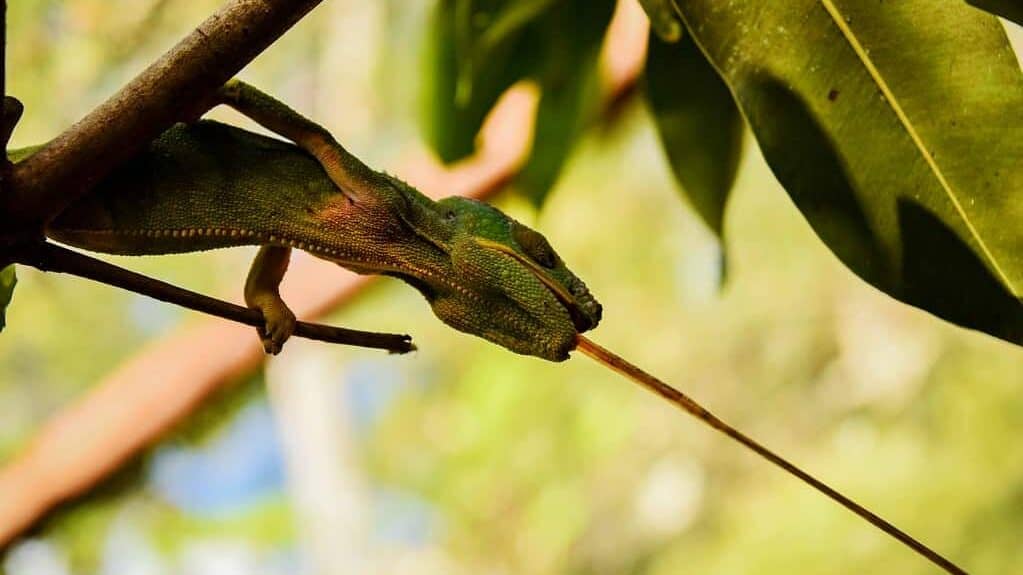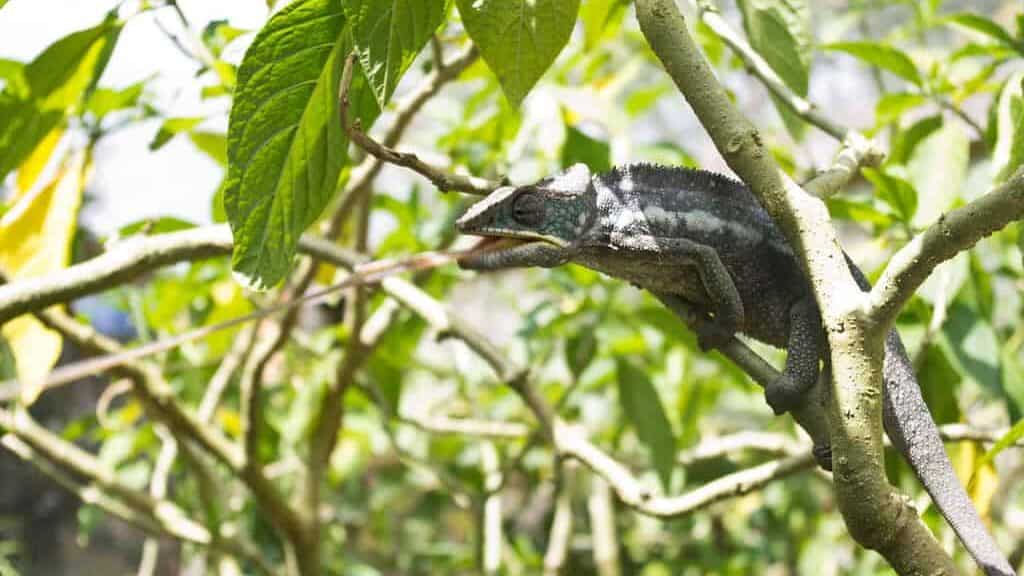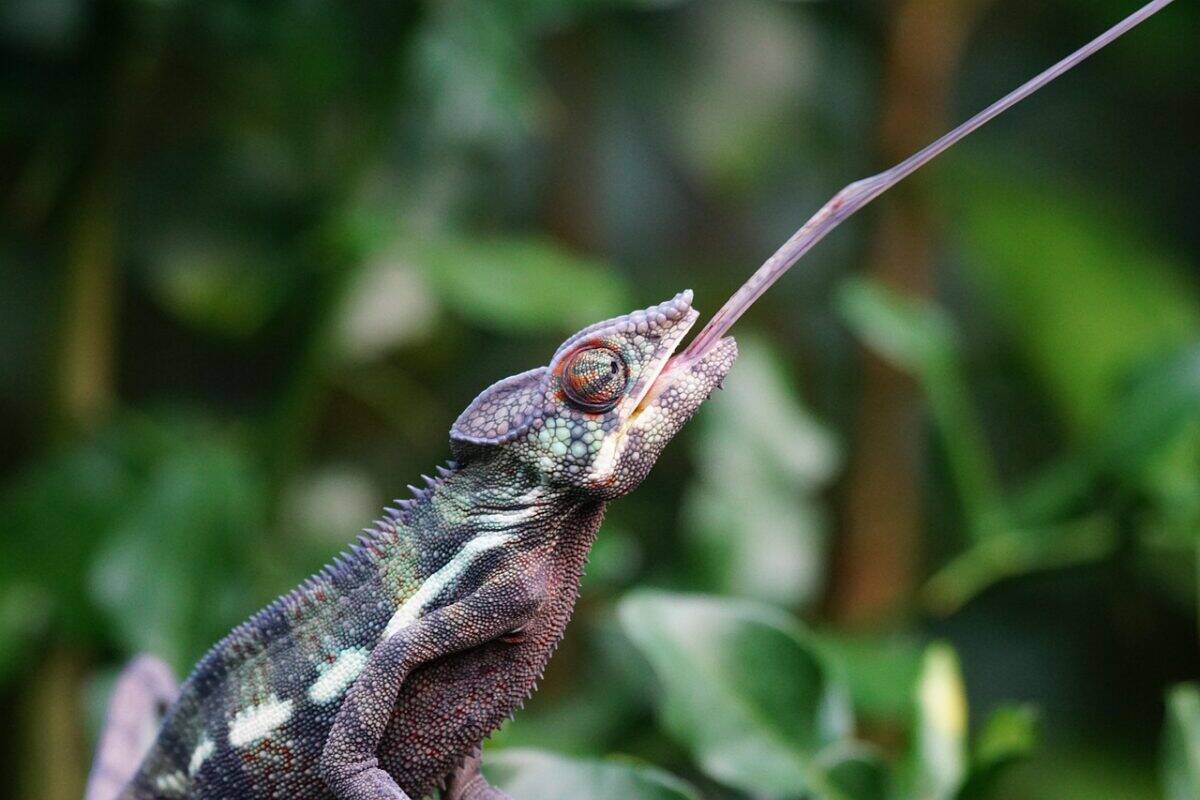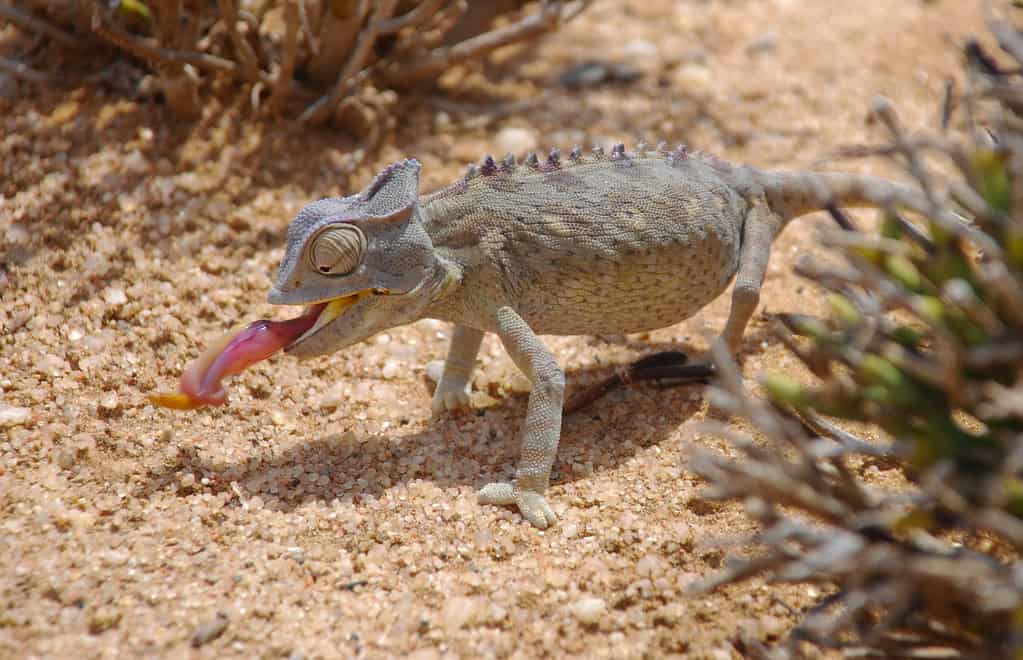Chameleons have developed one of the most remarkable hunting adaptations in the animal kingdom. Unlike most vertebrates, these lizards possess the extraordinary ability to move each eye independently of the other, creating a visual superpower that maximizes their hunting efficiency. This specialized adaptation allows chameleons to simultaneously scan different parts of their environment, effectively doubling their field of vision without moving their heads. As ambush predators that rely on stealth and precision, this independent eye movement gives chameleons a distinct advantage when stalking insects and other small prey. This article explores the fascinating mechanics, evolutionary development, and practical applications of chameleons’ independent eye movement during hunting, revealing how this unique adaptation has helped these reptiles become master predators despite their generally slow-moving nature.
The Anatomy Behind Independent Eye Movement

Chameleons possess specialized eye anatomy that enables their remarkable independent movement capabilities. Each eye is housed in a conical turret-like socket that protrudes from the sides of the head, allowing for an impressive 180-degree horizontal and 90-degree vertical range of motion. Unlike human eyes, which are connected by shared muscle groups, chameleon eyes operate on separate muscle systems, with each eye controlled by individual sets of muscles that can contract and rotate independently of one another.
This unique anatomical structure includes a small exposed portion of the eyeball (smaller than most lizards) with the majority hidden within the orbital socket. The exposed portion acts as a pinhole lens with a negative cornea that creates a highly magnified image. Additionally, chameleon eyes contain specialized accommodating lenses that allow them to focus precisely on objects at varying distances. This combination of anatomical features creates the foundation for their extraordinary visual capabilities that are essential for hunting success.
Evolution of Monocular Vision

The evolution of chameleons’ independent eye movement represents a fascinating example of natural selection at work. Scientists believe this adaptation developed as chameleons evolved into specialized arboreal hunters. Living in complex three-dimensional environments like trees and bushes required the ability to monitor predators and prey in multiple directions simultaneously. Over millions of years, chameleons with greater eye mobility gained survival and hunting advantages, leading to the refinement of this trait.
This evolutionary path differs significantly from most vertebrates, which developed binocular vision (where both eyes focus on the same point) to enhance depth perception. Chameleons instead prioritized expansive visual coverage through monocular vision. The evolutionary trade-off sacrificed some depth perception capabilities when using both eyes independently but compensated with an almost 360-degree field of view. When prey is detected, chameleons can then converge both eyes to achieve the binocular vision needed for accurate distance calculation before striking—representing a remarkable evolutionary compromise that optimizes both surveillance and precision hunting.
The Hunting Process: From Surveillance to Strike

A chameleon’s hunting sequence demonstrates the perfect integration of independent eye movement with other specialized adaptations. The process typically begins with surveillance mode, where the chameleon uses its independently rotating eyes to scan different sectors of its surroundings simultaneously. One eye might monitor the branches above while the other scans the ground below, effectively doubling the area under observation. This vigilant scanning continues until potential prey is detected, at which point the chameleon’s hunting strategy shifts dramatically.
Once prey is located, the chameleon enters targeting mode by converging both eyes on the insect, switching from independent movement to binocular vision. This convergence enables precise depth perception and distance calculation, critical for the accuracy of their ballistic tongue projection. The entire body remains motionless during this process, with only the eyes moving to track the prey. Once the target is locked, the chameleon launches its specialized tongue with remarkable precision, sometimes extending to more than twice its body length in just a fraction of a second. This entire sequence—from independent surveillance to binocular targeting to strike—showcases how the chameleon’s visual system seamlessly transitions between different modes to optimize hunting success.
Visual Processing in the Chameleon Brain

The chameleon’s brain has evolved specialized neural pathways to process the complex visual information coming from its independently moving eyes. Unlike humans, who combine signals from both eyes into a single integrated image in the visual cortex, chameleons possess separate neural processing centers for each eye. This parallel processing allows them to simultaneously interpret two completely different visual scenes—a computational feat that would be overwhelming for most vertebrate brains.
When a chameleon shifts from independent eye movement to binocular vision during targeting, its brain rapidly reconfigures visual processing to integrate information from both eyes. Researchers have identified specialized neurons in the chameleon’s optic tectum that activate only during this convergent viewing phase, helping calculate precise spatial coordinates of prey. This neural flexibility, switching between separate and integrated visual processing, represents one of the most sophisticated visual systems in the reptile world and is fundamental to the chameleon’s hunting success in complex three-dimensional environments.
Calculating Strike Distance Through Binocular Vision

Perhaps the most critical moment in a chameleon’s hunting sequence occurs when it transitions from independent eye movement to binocular focusing to calculate strike distance. When both eyes converge on prey, the chameleon gains stereoscopic vision, which allows it to perceive depth with remarkable precision. Studies have shown that chameleons can judge distances with accuracy within a few millimeters—essential for their ballistic tongue projection method of hunting, which provides no opportunity for mid-course corrections once launched.
This distance calculation relies on triangulation principles similar to those used in rangefinders. The angle between the two converged eyes, combined with the known distance between them, allows the chameleon’s brain to compute the exact distance to the prey. Researchers have demonstrated that chameleons will refuse to strike at prey if one eye is temporarily covered during this critical calculation phase, indicating how essential binocular vision is to their hunting success. This sophisticated distance calculation system represents the perfect complement to their independent eye movement, creating a complete visual package that optimizes both detection and capture of prey.
Camouflage and Stealth: The Perfect Complement to Vision

Chameleons’ independent eye movement works in perfect harmony with their renowned camouflage abilities to create an exceptionally effective hunting strategy. Their color-changing capability allows them to blend into their surroundings, remaining virtually invisible to both predators and prey. This camouflage would be significantly less effective if chameleons needed to move their heads or bodies to scan their environment. Instead, their independently moving eyes allow them to maintain complete bodily stillness while still monitoring large areas around them.
This combination of adaptations creates the perfect ambush predator. A camouflaged chameleon can remain motionless on a branch for hours, with only its eyes moving as it searches for prey. Even when prey is detected, the chameleon can track it without betraying its position through body movement. Only when the prey moves within striking range does the chameleon break its statuesque pose for the lightning-fast tongue projection. This integration of visual capabilities with physical camouflage demonstrates how different evolutionary adaptations can complement each other to create a remarkably efficient hunting system optimized for the chameleon’s ecological niche.
Species Variations in Visual Abilities

The chameleon family (Chamaeleonidae) includes approximately 200 species, and notable variations exist in their visual capabilities across different species. These differences often correlate with their specific ecological niches and hunting strategies. For instance, larger chameleon species that primarily hunt larger, faster-moving prey typically have more pronounced independent eye movement capabilities and more powerful binocular vision when converging their eyes. The Parson’s chameleon (Calumma parsonii) of Madagascar, one of the largest species, demonstrates exceptional visual acuity and range of motion.
In contrast, smaller chameleon species like the pygmy chameleons (Brookesia) have less dramatic eye mobility but still maintain the fundamental independent movement capabilities. Habitat also influences visual adaptations, with forest-dwelling species typically having different optimizations than those living in more open environments. Desert-adapted species like the Namaqua chameleon (Chamaeleo namaquensis) have developed additional visual adaptations to deal with intense sunlight and different prey detection challenges. These variations across species demonstrate how the basic principle of independent eye movement has been fine-tuned through evolution to match the specific ecological demands faced by different chameleon populations.
Comparing Chameleon Vision to Other Animals

Chameleons’ independent eye movement represents just one evolutionary solution to the challenge of expansive visual coverage. Other animals have developed different adaptations to achieve similar goals. For instance, many prey species like rabbits and deer have eyes positioned on the sides of their heads, providing a wide field of view but with limited depth perception. Fish species such as flounders have evolved the ability to move their eyes independently to some degree, though not with the same range or precision as chameleons.
What makes chameleons truly unique is their ability to switch between independent eye movement and coordinated binocular vision. Most animals must commit to either excellent depth perception (like eagles and humans) or a wide field of view (like rabbits), but chameleons have evolved the best of both worlds. Their system also differs from that of other reptiles with good visual abilities, such as certain monitor lizards, which achieve comprehensive visual coverage through head movement rather than independent eye control. The chameleon’s solution is particularly energy-efficient, requiring minimal movement to monitor a large area—a perfect adaptation for an ambush predator that relies on stillness and surprise.
Limitations and Challenges of Independent Eye Movement

Despite its advantages, the chameleon’s independent eye movement system does come with certain limitations. When operating in independent surveillance mode, chameleons sacrifice some of the benefits of binocular vision, including depth perception and contrast sensitivity. This means that while they can detect movement across a wide field, they may not immediately recognize what they’re seeing or how far away it is until they converge both eyes on the object of interest. Studies have shown that chameleons take slightly longer to react to potential threats or prey at the periphery of their visual fields compared to objects directly in front of them.
Additionally, processing two separate visual fields simultaneously requires significant neural resources, potentially limiting the processing power available for other cognitive functions. Researchers have observed that chameleons sometimes appear to “switch” attention between eyes rather than truly processing both visual fields with equal attention simultaneously. There are also physical constraints, as the eye muscles can fatigue during extended periods of surveillance. Despite these limitations, the overall system represents an excellent evolutionary compromise that optimizes the visual capabilities most critical for the chameleon’s survival and hunting success in its natural environment.
Scientific Research and Discoveries

Scientific understanding of chameleon vision has advanced significantly in recent decades through sophisticated research techniques. High-speed cameras have allowed researchers to precisely measure the timing and coordination of eye movements during hunting sequences. One groundbreaking study led by Dr. Keren Shamiz of the University of Haifa used specialized eye-tracking technology to document how chameleons maintain independent eye movement until prey is detected, at which point both eyes converge with remarkable synchronization within milliseconds.
Neuroimaging studies have provided insights into how the chameleon brain processes visual information from two independent sources. Research published in the Journal of Comparative Neurology revealed specialized regions in the chameleon’s optic tectum that activate differently depending on whether the eyes are operating independently or in coordinated fashion. Another fascinating discovery came from the University of Geneva, where researchers documented that chameleons can actually focus on objects at different distances with each eye simultaneously—a capability not found in any other vertebrate studied to date. These scientific advances continue to deepen our understanding of the remarkable complexity behind what appears, on the surface, to be simply “eyes that move independently.”
Technological Applications Inspired by Chameleon Vision

The chameleon’s remarkable visual system has inspired various technological innovations, particularly in the fields of robotics and surveillance systems. Engineers have developed cameras with independent movement capabilities modeled after chameleon eyes, allowing for simultaneous monitoring of multiple areas without requiring multiple fixed cameras. These systems have applications in security, wildlife monitoring, and industrial quality control where comprehensive visual coverage is essential.
Biomimetic research has also led to advances in visual processing algorithms that can handle multiple independent visual streams simultaneously, similar to how a chameleon processes information from its independently moving eyes. These algorithms have applications in autonomous vehicles and drones, allowing them to monitor different sectors of their environment with greater efficiency. The chameleon’s ability to switch between independent and coordinated eye movement has even influenced the development of adaptive vision systems that can transition between wide-area surveillance and focused targeting modes based on situational demands. These technological adaptations demonstrate how understanding natural adaptations can lead to innovative solutions to complex engineering challenges.
Conclusion: Nature’s Visual Masterpiece

The chameleon’s independent eye movement system represents one of nature’s most sophisticated visual adaptations, perfectly tailored to the hunting requirements of these remarkable reptiles. By enabling simultaneous surveillance of different areas followed by precise binocular targeting, this visual system optimizes both prey detection and capture efficiency. The seamless integration of independent movement, coordinated convergence, distance calculation, and tongue projection demonstrates the power of evolutionary processes to develop highly specialized solutions to ecological challenges.
Beyond their practical hunting applications, chameleons’ eyes provide valuable insights for both biological research and technological innovation. They illustrate how specialized sensory adaptations can develop when driven by specific environmental pressures and demonstrate the remarkable diversity of visual systems that have evolved across different animal groups. As we continue to study these fascinating reptiles, we gain not only a deeper appreciation for the complexity of their hunting strategies but also inspiration for new approaches to solving visual challenges in technology and engineering. The chameleon’s independent eye movement capability stands as a testament to nature’s ingenuity and the remarkable diversity of adaptations that have evolved in the animal kingdom.
- How Chameleons Use Independent Eye Movement to Hunt - August 10, 2025
- Animals We Eat (That Were Once Worshipped by Ancient Civilizations) - August 10, 2025
- What Scientists Found in Ice Cores From Alaska Will Shock You - August 9, 2025

